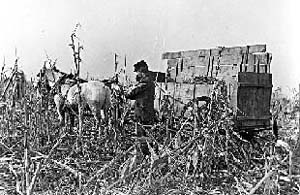Objective: Students will be able to name and describe types of farming tasks and the roles played by family members in the backgrounds of Frank Sadorus' images in the ISM collection, and to compare them to tasks today.
Grade Levels: Middle School
Time Required: one class period
What do you know? Have the students make a list of all the farm tasks they can think of (brainstorm and write them on the board or a large card to post in the room).
Motivation:
Look through the
photographs in the Sadorus Collection. Frank Sadorus took photographs
during the off-season when he wasn't doing farm work, but there are
clues to the farm tasks in the backgrounds of his images. Use one photograph as an example of analysis (see below).
Procedure:
Choose a photograph.
Examine it and list the jobs that people are doing in the scene.
Add to the list other jobs, the results of which may be seen in the
photos, that were necessary for family life, such as cooking, washing
clothes, and sweeping house.
Finally, group the jobs by type, by gender role, or other category.
Compare this
list of tasks in the photograph to the jobs around our homes today.
In which ones are children expected to participate? How much time is
involved doing these tasks versus leisure time? Frank took photographs
in his leisure time. What activities were the family members participating
in when he photographed them? Some of the digital images are the text
from notes and postcards that he wrote. What information did you learn
from those about farm jobs and activities?
 Example:
This photo shows Frank Sadorus picking corn. Related tasks are:
Example:
This photo shows Frank Sadorus picking corn. Related tasks are:
-Hitching horses up to wagon
-Driving horse and wagon to field
-Caring for horses - currying, feeding, mucking, shoeing
-Maintaining wagon, wheels, harness
-Plowing the field
-Planting corn
-Weeding the field
-Picking corn
-Shucking corn
-Storing corn in silo or bins
-Stacking corn stalks at end of season
-Processing seed for food, feed, seed, or sale
Which jobs are seasonal? Which jobs did males have? Which jobs did females have?
With which jobs did children help?
Illinois State
Board of Education Goals: Social Studies:
Middle School:
18.B.2b Describe the ways in which institutions meet the needs of
society. (How did the family meet their own economic needs and those
of its community?)
18.B.3a Analyze how individuals and groups interact with and
within institutions. (What roles did the family members play in the
running of the farm?)
18.A.3b Explain how social institutions contribute to the development
and transmission of culture. (How did the family structure on the farm
bring stability and extend tradition in Sadorus? How did things change
with the death of the head of the family? What other factors played
a role?)
Assessment:
Students can check one anotherís lists for accuracy (print out photos).
Rubric: ∑ Several tasks have been identified.
∑ The probable
gender and age of the worker has been identified.
∑ Student has listed tasks
identified by analyzing an object or action in the photo in addition
to the obvious primary task depicted.
∑ The list of comparable tasks
of today is complete and parallel to first list.
∑ The list of childrenís
chores shows analysis, contrast of eras, and awareness of change in
technology and family culture.

